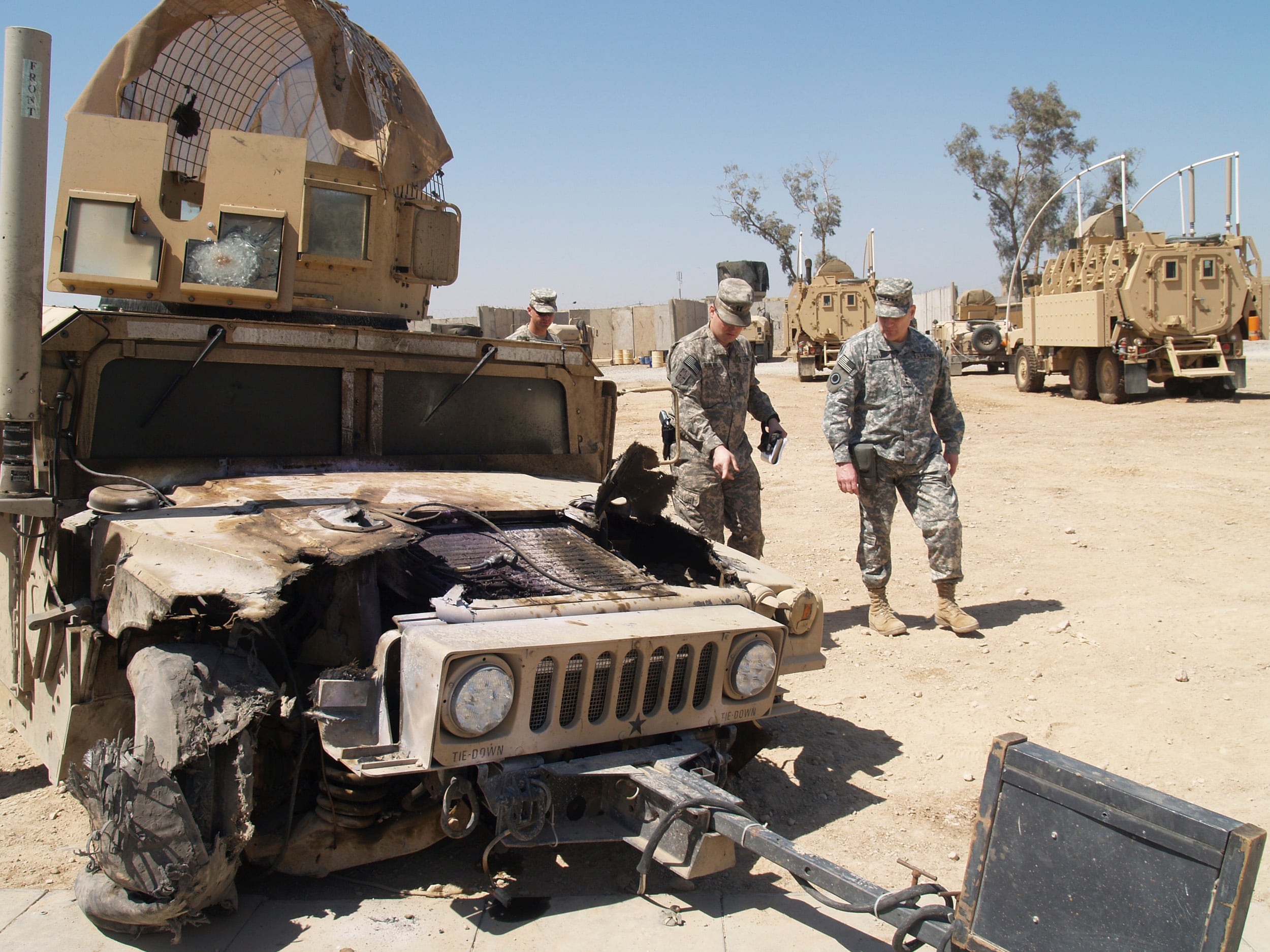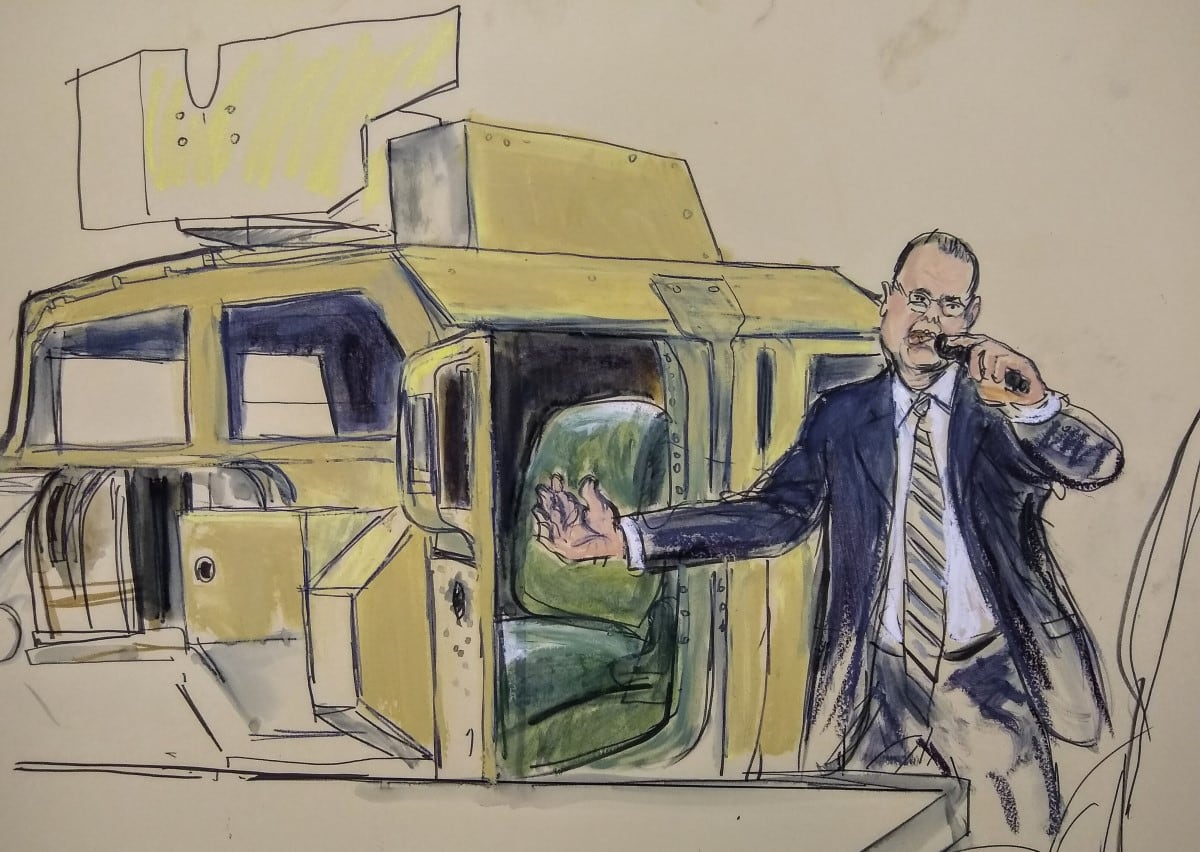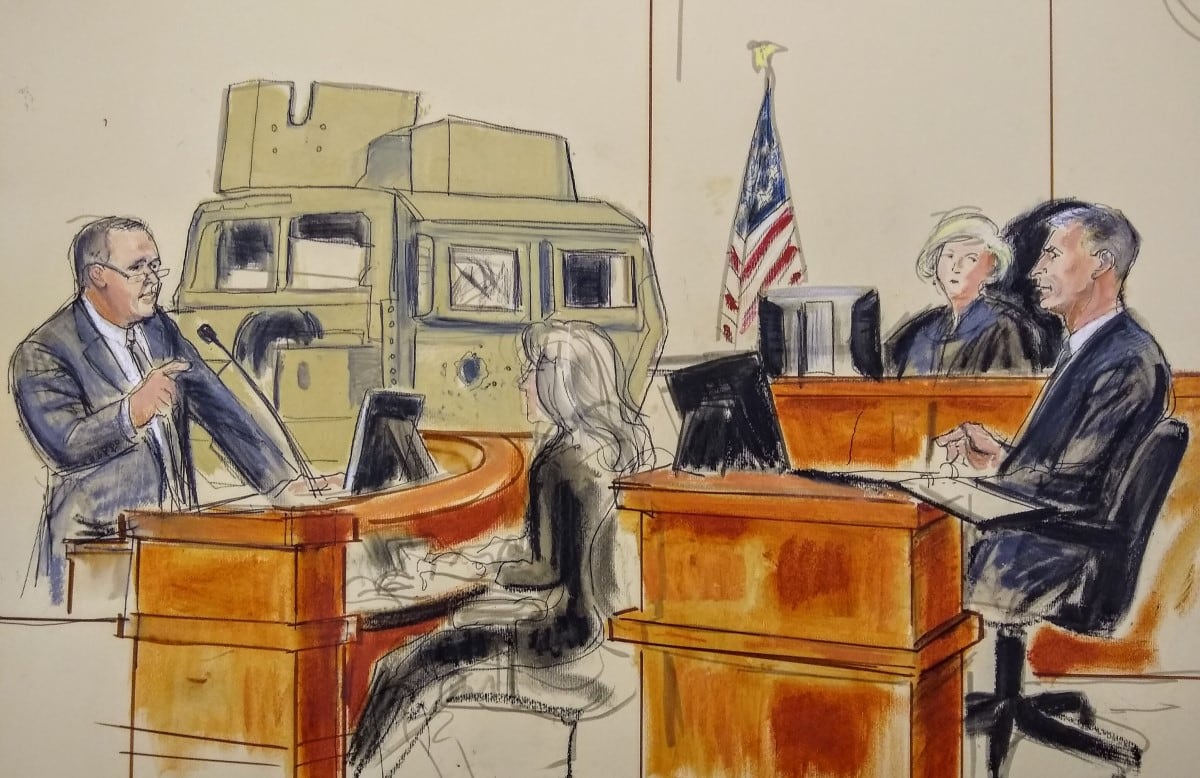Army Pfc. Robert Bartlett drove the lead Humvee in a three-vehicle convoy down Route Pluto in Baghdad, Iraq.
He and the other three soldiers in the truck were one sector away from finishing their days’ worth of presence patrols and reconnaissance.
He snaked the truck through the concrete barriers that dotted the neighborhoods. It was May 2005; he’d joined shortly after the 2003 Iraq invasion. The Arizona native had become a soldier at age 30 but had completed cavalry scout training and sniper training before his first deployment.
On Monday, as he recounted the events of that day in federal court in Washington, Bartlett explained that though he was older than many of the soldiers who outranked him, he looked at his superiors in the truck and the rest of the unit like little brothers.
He’d do anything to protect them, he testified. But neither he nor those in the truck — or even at some of the highest levels of the U.S. military — had a firm grasp on the dangers they faced or their origin.
A three-day federal trial that began this week pits both a New Jersey and Arkansas law firm against the Islamic Republic of Iran, alleging that the regime funneled funds, personnel and training in a long-running and deeply organized plot to exact as much damage as possible on U.S. and coalition troops in Iraq — all to keep the country destabilized and further their political and military aims.
The attorneys began laying out evidence that involves long-term planning, millions of dollars, and taking a shotgun approach by backing factions that often fought each other but who could all be counted on to attack the U.S. They did so without objection. Iran didn’t send any attorneys.
If successful, the more than 200 plaintiffs in this case could be considered eligible to receive confiscated or forfeited funds being gathered in an account for victims of terrorist acts.
Past cases involving embassy bombings and other attacks have been litigated, and the fund has paid out more than $1 billion. This is not the only case involving Iran or other entities such as the terrorist group Hezbollah and other state sponsors of terrorism such as Sudan and Cuba. There could be as many as 6,000 eligible victims, according to officials.
But this week’s case focuses on 90 separate attacks and the victims and their families who’ve suffered death, dismemberment and lifelong trauma as a result of Iran’s campaign. They want $10 billion.
RELATED

Retired Army Col. Kevin Farrell recounted some of the bigger picture that 1st Battalion, 64th Armored Regiment faced during the year they spent in Iraq. Farrell walked through the motor pool and saw shredded vehicles, but many carried a similar marking — a cleanly cut, 4-inch diameter hole.
“We weren’t sure what it was,” the colonel said.
They knew what improvised explosive devices were — that was common knowledge by the time they’d deployed. But this was different. There was nothing “improvised” about these weapons.
His staff pushed the intelligence up the chain. They got a lukewarm response.
“A bomb is a bomb, what’s the difference?” higher command said.

In milliseconds on a Baghdad road, Bartlett and his team found out.
The blast seared through the driver’s side where the door meets the roof. A blazing hot ball of copper split into Bartlett, ripping across his face and jaw, and rocketing across the front of the cab, slicing off the top of Staff Sgt. William Brooks’ head, killing the truck commander and friend instantly.
The other half of the metal projectile blew Staff Sgt. Edwin Greer out of the rear driver’s side seat and onto the highway. But it kept going, taking Cpl. Todd Bishop’s legs with it.
The gunner had been resting on the low-slung cargo strap. Out of shock, he tried to stand. Adrenaline pounding, he didn’t know that little was left to help him do that.
He tumbled down.
Simultaneously, Bartlett reached back with a burnt, broken hand and pulled Bishop toward him, shoving him toward the front of the cab and pulling his legs straight.
Greer had recovered and was pounding open the warped, driver’s door to get to the pair.
Smoke filled the cabin. Those still living could smell burnt flesh, hair and diesel fuel.
Huddling in their own private hell, Bishop put his arms around Bartlett.
“I threw my arms around him, we were gonna die together,” Bartlett said.
The four soldiers in that vehicle and potentially 1,000 others killed or wounded as a result of Iran’s influence were hit with a variety of lethal means. But the centerpiece of the majority of the attacks was the more sophisticated explosively formed penetrator, or EFP.
The roots of that simple but deadly weapon and its use against U.S. forces in Iraq can in some ways be traced back to decades before, when, after the Iranian revolution, Iran formed the Iranian Republican Guard Corps-Quds Force with the explicit mission of pushing Iran’s aims outside of the country.
In a short time, they found their first willing disciples when they sent an estimated 1,500 of their Quds Force trainers to Lebanon to help form and direct the fledgling militant groups into one unit, “Hezbollah,” testified Matthew Levitt, director of the Washington Institute for Near East Policy and author of “Hezbollah: the global footprint of Lebanon’s Party of God.”
They were quick learners. Between 1983 and 1996, the terrorist group could claim credit for more than 600 dead in just the major attacks they’d carried out in their country, South America and Saudi Arabia, including the 1983 Marine barracks bombing that killed 241 U.S. service members.
And Hezbollah marched on, as it continues to conduct assassinations and other attacks in places as wide-ranging as Azerbaijan, Cyprus, Bulgaria and Thailand.
At nearly the same time as Iran was feeding funding, training and weapons to Hezbollah, it began supporting other aims just across its border. From 1980 to 1988, during the Iran-Iraq War, Iran supported the Badr Corps, a Shia group loyal to Iran within Iraq.
The U.S. invasion of Iraq in some ways came at a time tailor-made for Iran and its terrorist proxies such as Hezbollah and other groups already inside Iraq.
Early versions of the EFP began showing up in Hezbollah attacks against Israeli adversaries in Lebanon and elsewhere in the late 1990s.
By 2003, Hezbollah had improved the technology, through funding and training from Iran. Shortly after the U.S.-led invasion toppled dictator Saddam Hussein, the Badr Corps came out from the shadows and rebranded itself the Badr Organization, Levitt testified.
Another wrinkle that proved an Achilles heel for U.S. forces was an underestimation of the explosives threat they would face post-invasion.
The entire U.S. Army invasion force brought with it just three companies of explosives ordnance disposal soldiers. That’s 66 people.
Each company had a single robot for neutralizing bombs, but they didn’t bring them along for the invasion, retired Army Col. Leo Bradley, an EOD expert who commanded multiple such units over his career, testified.
In the first year of the war, the 52nd Ordnance Corps would report 17,025 EOD responses, the bulk of those small arms and munitions left over from Saddam’s stockpiles. For example, out of 18 million pieces of weapons, ordnance and ammunition destroyed, only 1,478 were IEDs, Bradley said.
Within a few short years, just one of the four main zones of Iraq would see 1,000 IED attacks a month.
And with each new bombing season, the attacks would become more coordinated and the equipment more sophisticated.
From simple artillery shells with low power radio-controlled detonators, to pressure plates, then cell phone triggers to command wire controls and onto passive infrared, the bombs and bombers were getting better.
The U.S. responded, first with soldiers welding “hillbilly armor” to their thin-skinned Humvees, then with uparmored Humvees, and finally to Mine Resistant, Ambush Protected armored vehicles with V-shaped hulls.
The Iranian designed and supplied EFP would thwart those efforts.
Backing those efforts was the Ramazan Corps, a unit within the Badr Organization whose specific mission was to smuggle arms and fighters into and out of Iraq, mostly through the porous Iranian border.
This was happening largely under the eye of Iraqi military and police accomplices, sympathetic to or bribed by Iranian agents.
And as this ever-more complicated web threaded its way into the core of Iraqi politics early in the war, the coalition forces, especially the U.S. component, was focused in the other direction.

Retired Army Lt. Gen. Michael Oates commanded units with the 10th Mountain Division and 101st Airborne Division on tours in Iraq, retiring after a stint with the Joint Improvised Explosive Device Defeat Organization, or JIEDDO.
Oates testified that following the de-Baathification priority, which removed Baath Party associates from nearly all government and leadership positions, a Sunni-led uprising pulled the military and political focus to quelling that violence and those problems.
The Baath Party had been Saddam’s party when he was in power and was predominately Sunni.
That allowed space for Shia militant groups such as the Mahdi Army of Muqtada al Sadr, to grow. That army splintered, providing more anti-U.S. groups to form and receive funding, proliferating the use of EFPs, IEDs and other attack methods being drilled into groups by both Hezbollah, Badr, and other groups loyal to Iran’s aims, Levitt testified.
It was those sophisticated, devious methods of killing and maiming U.S. and coalition troops like Bartlett and his friends.
Sitting on the witness stand, the product of nearly five years’ worth of surgeries and rehabilitation at Walter Reed Army Medical Center, Bartlett’s external scars can’t be missed.
He described the pain of the blast.
“It was like a molten hot sledge hammer hit me in the face,” he said.
Permanent nerve damage keeps that pain fresh.
“It’s like my face is on fire all of the time,” he said.
His internal wounds may never heal.
The “big brother” role is one he took seriously — and still does.
“It’s survivor’s guilt,” he said, recalling how Brooks, the staff sergeant who died in the blast, had a wife and two children. He was single.
His tour ended that May day, while the unit’s went on for the rest of the year. Other friends were lost.
“I feel guilty that I wasn’t there to bring them home safe,” he said.
Gary Osen, the lead plaintiffs' attorney, asked two simple questions at the end of his examination of Oates, the retired three-star.
“Did the U.S. ever develop a successful countermeasure for the EFP?” Osen asked.
“No,” Oates said.
“Did Iran ever suffer any consequences for its support and development of EFPs?” Osen asked.
“No,” Oates said.
The first question continues to be pursued by researchers and tacticians at various levels.This trial is one attempt to answer the second question.
Todd South has written about crime, courts, government and the military for multiple publications since 2004 and was named a 2014 Pulitzer finalist for a co-written project on witness intimidation. Todd is a Marine veteran of the Iraq War.





